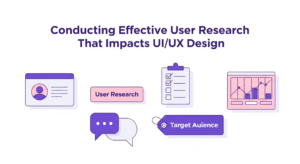click to get service View profile
Learn how to identify and avoid the top 7 Cognitive Biases in UX Research that can impact your findings. Improve your design decisions with effective strategies to reduce bias in user studies.
In the world of UX research, cognitive biases in UX research often act as an invisible force, subtly influencing our findings and shaping design decisions. These mental shortcuts — the automatic ways our brains process information — can lead us to make assumptions that aren’t rooted in real user data. When left unchecked, these biases can distort research insights, ultimately impacting the user experience you’re striving to improve. Being aware of and addressing these biases is crucial for ensuring that your UX research remains accurate, objective, and effective.
In this guide, we’ll dive into the Top 7 Cognitive Biases in UX Research, show you how to recognize them in your work, and provide practical strategies to avoid them. By understanding and overcoming these biases, you can ensure that your research stays objective, your designs are data-driven, and your users’ needs are met more effectively.
What is Cognitive Bias?
Cognitive biases in UX research are systematic patterns of deviation from rational thinking that can influence how users behave—and how researchers interpret that behavior. These biases stem from the brain’s natural tendency to simplify complex information, often leading to flawed reasoning, distorted perception, and inaccurate memory. Recognizing these biases is essential for conducting objective and reliable UX research that truly reflects user needs.
In the context of cognitive biases in UX research, these mental shortcuts can significantly distort how researchers interpret user data and make design decisions. For instance, confirmation bias can cause researchers to focus only on data that supports their assumptions, while anchoring bias may lead them to give too much weight to initial information. Such biases can result in misleading insights that fail to accurately reflect the true needs and behaviors of users.
Understanding and addressing cognitive biases in UX research is essential for maintaining objectivity and validity in your findings. By mitigating these biases, you ensure that your UX research is grounded in real user behavior and needs, rather than skewed by distorted perceptions. This approach leads to more accurate insights and helps create a user experience that truly reflects what users want and how they interact with your product.
Top 7 Cognitive Biases trong UX Research

1. Confirmation bias
Confirmation bias is one of the most common cognitive biases in UX research. It occurs when a researcher selectively searches for, interprets, and remembers information that supports their existing hypothesis, while disregarding or undervaluing conflicting data. This tendency can lead to skewed research findings that do not accurately represent user behavior or needs, ultimately compromising the effectiveness of the design process.
Examples of Confirmation Bias in UX Research:
- Interviewing only those with similar viewpoints.
- Focusing only on information that supports the hypothesis.
- Using language or tone that guides participants to respond in a certain way.
2. Courtesy Bias
Courtesy bias is a common type of cognitive bias in UX research, where participants hesitate to express their true opinions, especially if those opinions conflict with others in the group. Driven by the desire to maintain social harmony, avoid confrontation, or fear negative judgment, this bias can result in skewed or incomplete insights, ultimately affecting the accuracy and reliability of the research findings.
Examples of Courtesy Bias in UX Research:
- Participants tend to agree with the opinions of others.
- Expressing opposing views cautiously or unclearly.
- Remaining silent when there are differing opinions.
3. Observer-expectancy Effect
The Observer-Expectancy Effect is a type of cognitive bias in UX research that occurs when a researcher unintentionally influences participants through their reactions—whether verbal or non-verbal—to the participants’ behavior or responses. These subtle cues can shape or alter the feedback provided, leading to biased or distorted research results that do not accurately reflect true user behavior.
Examples of Observer-Expectancy Effect in UX Research:
- Asking leading questions that guide participants.
- Smiling or nodding in agreement when participants provide positive feedback.
- Frowning or sighing when participants provide negative feedback.
4. Framing Effect
The Framing Effect is a form of cognitive bias in UX research where the way information or a problem is presented influences user decisions—even when the underlying options are identical. Subtle changes in wording, tone, or context can lead users to make completely different choices, highlighting the importance of neutral and consistent framing in research and design.
Examples of Framing Effect in UX Research:
- Asking leading questions.
- When asking “Are you satisfied with this product?”, users tend to give a more positive response than when asked “Are you dissatisfied with this product?”
5. Anchoring Bias
Anchoring bias is a common form of cognitive bias in UX research, where researchers unintentionally influence participants by presenting initial information that becomes a mental “anchor.” This starting point can skew how participants evaluate subsequent options or experiences, leading to biased responses and reducing the objectivity of the research findings.
Examples of Anchoring Bias in UX Research:
- Comparing a product with others that are either more expensive or cheaper.
- Offering the old interface version first, instead of letting participants experience the new interface independently.
6. False-consensus Bias
False-consensus bias is a common type of cognitive bias in UX research where researchers overestimate the extent to which others share their opinions, beliefs, or preferences. This bias can lead to UX design decisions that are based on incorrect assumptions, resulting in designs that do not effectively address the actual needs and preferences of users.
Examples of False-consensus Bias in UX Research:
- Designing the user interface based on personal preferences.
- Assuming that users will understand and use the product in the way the researcher expects.
- Ignoring user feedback because it’s seen as coming from a minority.
7. Empathy Gap
The Empathy Gap is a type of cognitive bias in UX research that occurs when researchers fail to fully understand or account for the impact of emotions on user behavior and decision-making. This bias can lead to an incomplete or inaccurate understanding of user experience and motivation, ultimately resulting in flawed research outcomes and misguided design decisions.
Examples of Empathy Gap in UX Research:
- Ignoring the feelings of confusion a new user may have when first using an app.
- Overlooking the psychological challenges older users face when using a product.
How to Avoid Cognitive Bias in UX Research
It is very difficult to completely eliminate cognitive bias during user research! However, you can still identify and significantly reduce the impact of your own biases through the following methods:

1. Identify Assumptions Before Research
When starting a research project, it’s natural to carry assumptions about users, products, or problems. However, these assumptions can introduce cognitive biases in UX research, subtly shaping how the research is conducted and potentially distorting the data collected. Recognizing and challenging these biases is essential for gathering accurate, unbiased insights.
To mitigate cognitive biases in UX research, it’s crucial to clarify assumptions early in the project and design the research to minimize their impact. One effective approach is Jennifer Ibrahim’s use of the 5W1H method, which helps identify and analyze potential biases, ensuring that the research remains objective and free from distortion.
- Who: Who do I believe the target users are?
- What: What problem does my solution solve for them?
- When: When will users use my product?
- Where: Where will users use my product?
- How: How will users use my product?
2. Combine Multiple Research Methods
Each research method has its own strengths and limitations, highlighting different aspects of the user experience. For instance, interviews capture users’ subjective perspectives, while direct observation reveals real behaviors. Choosing the right method—and being aware of how cognitive biases in UX research may influence each approach—is essential for collecting accurate and meaningful insights.
Relying on a single research method can lead to a limited perspective and increase the risk of being influenced by the researcher’s own cognitive biases.
Combining multiple research methods is a powerful strategy to minimize cognitive biases in UX research. It allows you to gather diverse, multidimensional data, increasing the reliability and validity of your findings. This holistic approach leads to more accurate insights and ultimately results in better, user-centered product design solutions.
3. Create an Open Sharing Environment
During interviews or focus groups, some participants may hesitate to share their honest thoughts or personal experiences—especially when their opinions differ from others in the group. This behavior is often influenced by cognitive biases in UX research, such as courtesy bias or groupthink, which can lead to incomplete or skewed insights if not properly managed.
To reduce the impact of cognitive biases in UX research, it’s important to create a safe and judgment-free environment where participants feel comfortable sharing openly. Emphasize that there are no right or wrong answers—only unique perspectives. When participants understand that their honest input contributes meaningfully to the product design and development process, they’re more likely to provide authentic and valuable insights.
Note: If you do not fully understand a participant’s response, ask open-ended questions like “Why do you think that?” and listen carefully to their answers. Avoid asking leading questions or interpreting their answers based on your own thoughts.
4. Maintain a Neutral Attitude
Your body language can unintentionally influence participant behavior due to the Observer-Expectancy Effect, a form of cognitive bias in UX research. For example, if you shake your head or react subtly when a user tries to click a specific button, they may change their action based on your cues—skewing the authenticity of the feedback and affecting the accuracy of your research results.
To gather the most natural and unbiased feedback from participants, it’s crucial to maintain a neutral attitude throughout the research process. By avoiding emotional reactions such as excitement, surprise, or disappointment, you can reduce the influence of cognitive biases in UX research, ensuring that participants’ responses are not swayed by your reactions.
5. Record the Facts, Not Opinions
Note-taking is an essential skill in UX research, yet it’s often underestimated. Whether you’re leading a session or simply observing, recording observations quickly and clearly helps prevent the influence of cognitive biases in UX research. Accurate notes will streamline the analysis process later, ensuring that insights are based on real data, not distorted recollections or assumptions.
To avoid being influenced by cognitive biases during note-taking, only record facts and observations objectively, rather than trying to explain participants’ behavior.
Example: If a participant frowns after opening a newly designed interface, note “The participant opened the new user interface, sighed, and frowned” instead of “The participant doesn’t like the new user interface.”
Note: If you want to understand the reason behind the participant’s reaction, ask questions to let them share their thoughts, rather than jumping to conclusions based on your own thoughts.
You might want to learn more about: What is UX Content? Why should you localize product content?
Conclusion
Recognizing and avoiding the top cognitive biases in UX research is crucial for making objective, data-driven decisions. By understanding how biases like confirmation bias, anchoring, and availability bias can subtly influence your findings, you can take actionable steps to minimize their impact. Implementing strategies like diversified user testing, using unbiased questions, and being aware of your own assumptions will help you gather more accurate insights. Ultimately, by reducing cognitive biases, you not only improve the quality of your UX research but also enhance the overall user experience, leading to more effective designs. Stay aware, stay objective, and keep refining your UX research process for better outcomes.

